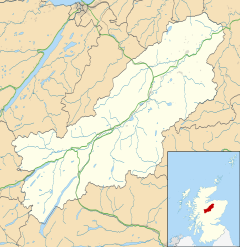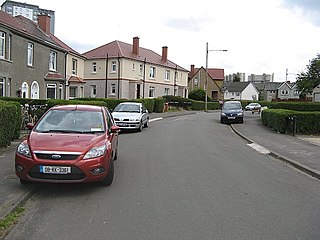
Cardonald is an outlying suburb of the Scottish city of Glasgow. Formerly a village in its own right, it lies to the southwest of the city and is bounded to the south by the White Cart Water. The area was part of Renfrewshire until 1926 when the villages of Cardonald, Crookston, Halfway and their surrounding farmland were annexed to Glasgow.

Badenoch is a traditional district which today forms part of Badenoch and Strathspey, an area of Highland Council, in Scotland, bounded on the north by the Monadhliath Mountains, on the east by the Cairngorms and Braemar, on the south by Atholl and the Grampians, and on the west by Lochaber. The capital of Badenoch is Kingussie.

Earl of Seafield is a title in the Peerage of Scotland. It was created in 1701 for James Ogilvy, who in 1711 succeeded his father as 4th Earl of Findlater. The earldoms of Findlater and Seafield continued to be united until 1811, when the earldom of Findlater became dormant, while the earldom of Seafield remains extant.
Knock, from the Gaelic, An Cnoc, is a village in Point peninsula on the Isle of Lewis in the Outer Hebrides of Scotland. Point is connected by road across a narrow isthmus to Stornoway, the main administrative centre of the Western Isles.

Clan Grant is a Highland Scottish clan.

Hurlford is a village in East Ayrshire, Scotland. It has a population of 4,968. Hurlford's former names include Whirlford and Hurdleford. The village was named Whirlford as a result of a ford crossing the River Irvine east of Hurlford Cross, near Shawhill. It shares its name in Gaelic, Baile Àtha Cliath with the Irish capital Dublin. The census locality is called Hurlford and Crookedholm.

Boat of Garten is a small village and post town in Badenoch and Strathspey, Highland, Scotland. In 1951, the population was less than 400; in 1971, it was almost 500; in 1981, it was almost 700, and the same in 2001.

Dreghorn is a village in North Ayrshire, Scotland, 3.5 kilometres east of Irvine town centre, on the old main road from Irvine to Kilmarnock. It is sited on a ridge between two rivers. As archaeological excavations near the village centre have found a significant neolithic settlement provisionally dated to around 3500 BC, as well as medieval structures, scholars have suggested that Dreghorn could be Britain's oldest continuously inhabited village. Both Irvine and Dreghorn have grown in size and they are now separated by the Annick Valley Park, which incorporates a footpath and National Cycle Route 73 on the route of the disused Irvine to Busby railway line. It had an estimated population of 3,450 in 2020.
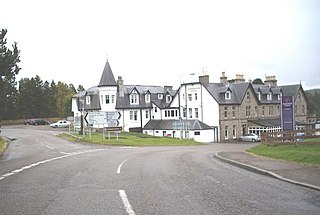
Carrbridge is a village in Badenoch and Strathspey in the Scottish Highlands. It lies off the A9 on the A938, west of Skye of Curr and southeast of Tomatin, near Bogroy. It has the oldest stone bridge in the Highlands and the nearby ancient pine forest contains the Landmark Forest Adventure Park.
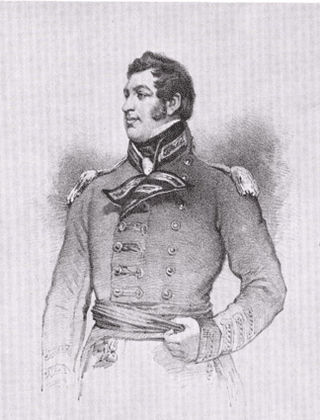
Francis William Ogilvy-Grant, 6th Earl of Seafield was a Scottish nobleman, a Member of Parliament and is listed as the 25th Chief of The Clan Grant. He served as Lord Lieutenant of Invernessshire.

John Charles Ogilvy-Grant, 7th Earl of Seafield, KT, styled Viscount Reidhaven from 1840 to 1853, was a Scottish nobleman. He is numbered as the 26th Chief of Clan Grant.
James Ogilvy-Grant, 9th Earl of Seafield, known for most of his life as the Hon. James Ogilvy-Grant, was a Scottish peer and Conservative Member of Parliament (MP).

Borve is a village on the west side of the Isle of Lewis in Scotland, 17 miles from the island's only town, Stornoway.

Gordon is a village in the Scottish Borders area of Scotland, within the historic county of Berwickshire. The village sits on the crossroads of the A6105 Earlston to Berwick on Tweed road and the A6089 Edinburgh to Kelso road. It is 6 miles (10 km) east of Earlston and 4 miles (6 km) west of Greenlaw.

Conan of Venarium is a fantasy novel by American writer Harry Turtledove, edited by Teresa Nielsen Hayden, featuring Robert E. Howard's sword and sorcery hero Conan the Barbarian. It was first published in hardcover by Tor Books in July 2003; a regular paperback edition followed from the same publisher in July 2004.

Rev. James Bain (1828–1911) was a minister of the established Church of Scotland and a noted controversialist who, though conservative in theology, sought to oppose a culture of deference to landlords in the Scottish Highlands and especially the influence of the Seafield Estates. In general, he defended the cause of the poor and of the ‘masses’ against the ‘classes’, utilising a slogan popularised by William Ewart Gladstone.

Duthil Old Parish Church and Churchyard is a historic site at the centre of the historical parish of Duthil near Carrbridge in Inverness-shire, in the Scottish council area of Highland. It is now maintained as a Clan Grant Heritage Centre.
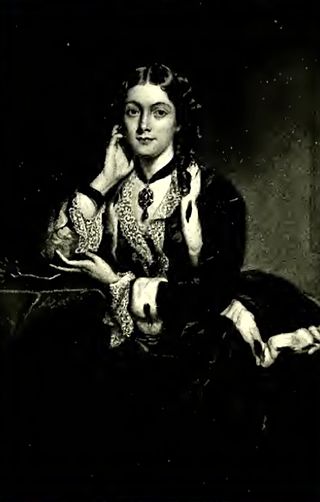
Caroline Stuart, Countess of Seafield, styled The Countess Dowager from 1884 to 1911, was a member of the Scottish aristocracy. She was proprietor of the Seafield Estates following the death of her son in 1884 and has been described as 'The last of the great feudal chiefs'.
Ewan Macleod (1847–1928) was a minister of the Free Church of Scotland who served as Moderator of the General Assembly in 1905/06.

Carrbridge Packhorse Bridge, also known as Coffin Bridge, is a bridge in the village of Carrbridge in the Highlands of Scotland. The bridge was built in 1717 to allow funeral processions to reach Duthil Church by crossing the River Dulnain. The parapets were washed away in the 19th century. In 1971 the bridge became a Category B listed building. It is now a popular tourist attraction.

